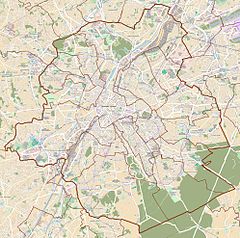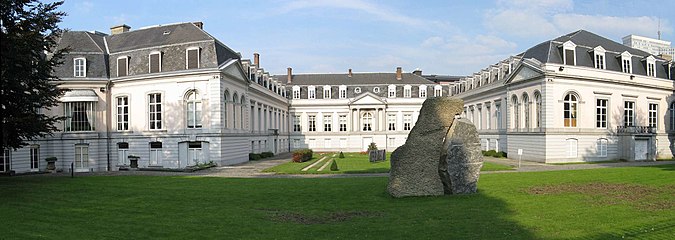Egmont Palace
| Egmont Palace | |
|---|---|
 View from the cour d'honneur (main courtyard) of the Egmont Palace | |
| Alternative names | Arenberg Palace |
| General information | |
| Type | Palace |
| Architectural style | Neoclassical |
| Address | Square du Petit Sablon / Kleine Zavelsquare 8 |
| Town or city | B-1000 City of Brussels, Brussels-Capital Region |
| Country | Belgium |
| Coordinates | 50°50′19″N 4°21′28″E / 50.83861°N 4.35778°E |
| Current tenants | Belgian Ministry of Foreign Affairs |
| Construction started | 1548 |
| Completed | c. 1910 |
| Client | Countess Françoise of Luxembourg and Lamoral, Count of Egmont |
| Owner | Belgian State |
| Designations | Protected (11/09/1992) |
| Other information | |
| Public transit access |
|
| Website | |
| Official website | |
| References | |
| [1] | |
The Egmont Palace (Template:Lang-fr, Template:Lang-nl), also sometimes known as the Arenberg Palace[2][3] (Template:Lang-fr, Template:Lang-nl), is a neoclassical palace in Brussels, Belgium. It was originally built between 1548 and 1560 for Countess Françoise of Luxembourg and Lamoral, Count of Egmont, though its appearance was heavily modified in the 18th century. It was partly destroyed by fire in 1892, after which it was once again reconstructed. Today, it houses the Belgian Ministry of Foreign Affairs.
The palace is situated in the Sablon/Zavel district (south-eastern part of Brussels' city centre), between the Rue aux Laines/Wolstraat and the Square du Petit Sablon/Kleine Zavelsquare. This site is served by Porte de Namur/Naamsepoort metro station (on lines 2 and 6 of the Brussels Metro), as well as the tram stop Petit Sablon/Kleine Zavel (on lines 92 and 93).
History
The original mansion was built between 1548 and 1560 for Countess Françoise of Luxembourg and her son, Lamoral, Count of Egmont, first in a Flemish Gothic, and later Renaissance style. Its fabric was dramatically transformed in the 18th century, when the property passed onto the Arenberg family, and the building was clothed in a neoclassical style. The plans for this stage are attributed to the early advocate of neoclassicism, Giovanni Niccolò Servandoni. After a fire demolished the oldest part of the building in 1892, it was reconstructed by the architect Octave Flanneau in a uniform neoclassical style.
The Egmont Palace was the host venue of the fencing events for the 1920 Summer Olympics in the garden.[4] After World War I, the German Arenberg family was forced to sell the property to the City of Brussels. During this time, the buildings, hardly recovering from the 1892 fire, were again damaged by fire in 1927 and 1959. In 1964, the property was sold to the Belgian State, which undertook its extensive restoration and redecoration.[2] In 1977, the Egmont Pact on the Belgian State reform was signed in the Egmont Palace during the second administration of then-Prime Minister Leo Tindemans.
Since 11 September 1992, the palace has been listed as a protected monument by the Monuments and Sites Directorate of the Brussels-Capital Region.[1] Nowadays, it is used for receptions and meetings by the Belgian Ministry of Foreign Affairs and hosts many events organised by the Royal Institute for International Relations (also known as the Egmont Institute).
-
The courtyard seen from Egmont Park
-
The main staircase
See also
- Egmont Group of Financial Intelligence Units
- List of castles and châteaux in Belgium
- Neoclassical architecture in Belgium
- History of Brussels
- Belgium in "the long nineteenth century"
References
Notes
- ^ a b Région de Bruxelles-Capitale (2016). "Palais d'Egmont / Palais d'Arenberg et le parc" (in French). Brussels. Retrieved 15 January 2022.
- ^ a b "A short history of the Egmont Palace". Egmont Palace. 20 August 2013. Retrieved 15 January 2022.
- ^ "Palais d'Egmont, Egmont I & II | Régie des Bâtiments". www.regiedesbatiments.be. Retrieved 15 January 2022.
- ^ Sports-reference.com profile of the 1920 Summer Olympics fencing events.
Bibliography
- D'Hoore, Walter (1991). Het Egmont-Arenbergpaleis te Brussel (in Dutch). Tielt: Lannoo. ISBN 978-90-209-1958-5.
- Laloire, Edouard (1952). Histoire des deux hôtels d'Egmont et du palais d'Arenberg (1383-1910) (in French). Brussels: Fr. Van Muysewinkel.
- Le Patrimoine monumental de la Belgique: Bruxelles (PDF) (in French). Vol. 1C: Pentagone N-Z. Liège: Pierre Mardaga. 1994.





